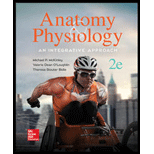
Concept explainers
_____ 1. Which cranial nerve is responsible for innervating the intrinsic and extrinsic tongue muscles?
- a. accessory (CN XI)
- b. glossopharyngeal (CN IX)
- c. trigeminal (CN V)
- d. hypoglossal (CN XII)
Introduction:
There are
Answer to Problem 1DYKB
Correct answer:
The hypoglossal nerve innervates intrinsic tongue muscle as well as the extrinsic tongue muscles. Therefore, option d. is correct.
Explanation of Solution
Reason for the correct statement:
Option d. is given as “hypoglossal (CN XII)”. There are nine pairs of cranial nerves which have somatic functions with the autonomic or sensory roles. The CN XII has only somatic motor function. This nerve innervates the extrinsic and intrinsic tongue muscles. Hence, intrinsic and extrinsic tongue muscles are innervated by hypoglossal or CN XII.
Hence, option d. is correct.
Reasons for incorrect statements:
Option a. is given as “accessory (CN XI)”. CN XI innervates the sternocleidomastoid and trapezius muscles. Hence, option a. is incorrect.
Option b. is given as “glossopharyngeal (CN IX)”. CN IX receives touch and taste sensation from one-third of the tongue and also innervates the parotid salivary gland and pharynx muscles. Hence, option b. is incorrect.
Option c. is given as “trigeminal (CN V)”. CN V innervates the muscles of mastication and receives sensory signals from the anterior scalp, meninges, nasal cavity, oral cavity, and face. Hence, option c. is incorrect.
Hence, options a., b., and c. are incorrect.
The hypoglossal nerve innervates the extrinsic and intrinsic muscles of the tongue.
Want to see more full solutions like this?
Chapter 13 Solutions
Anatomy & Physiology: An Integrative Approach
Additional Science Textbook Solutions
Biological Science (6th Edition)
Campbell Essential Biology (7th Edition)
Genetics: From Genes to Genomes
HUMAN ANATOMY
Chemistry: Structure and Properties (2nd Edition)
Biology: Life on Earth with Physiology (11th Edition)
- In one paragraph show how atoms and they're structure are related to the structure of dna and proteins. Talk about what atoms are. what they're made of, why chemical bonding is important to DNA?arrow_forwardWhat are the structure and properties of atoms and chemical bonds (especially how they relate to DNA and proteins).arrow_forwardThe Sentinel Cell: Nature’s Answer to Cancer?arrow_forward
- Molecular Biology Question You are working to characterize a novel protein in mice. Analysis shows that high levels of the primary transcript that codes for this protein are found in tissue from the brain, muscle, liver, and pancreas. However, an antibody that recognizes the C-terminal portion of the protein indicates that the protein is present in brain, muscle, and liver, but not in the pancreas. What is the most likely explanation for this result?arrow_forwardMolecular Biology Explain/discuss how “slow stop” and “quick/fast stop” mutants wereused to identify different protein involved in DNA replication in E. coli.arrow_forwardMolecular Biology Question A gene that codes for a protein was removed from a eukaryotic cell and inserted into a prokaryotic cell. Although the gene was successfully transcribed and translated, it produced a different protein than it produced in the eukaryotic cell. What is the most likely explanation?arrow_forward
- Molecular Biology LIST three characteristics of origins of replicationarrow_forwardMolecular Biology Question Please help. Thank you For E coli DNA polymerase III, give the structure and function of the b-clamp sub-complex. Describe how the structure of this sub-complex is important for it’s function.arrow_forwardMolecular Biology LIST three characteristics of DNA Polymerasesarrow_forward
 Medical Terminology for Health Professions, Spira...Health & NutritionISBN:9781305634350Author:Ann Ehrlich, Carol L. Schroeder, Laura Ehrlich, Katrina A. SchroederPublisher:Cengage LearningSurgical Tech For Surgical Tech Pos CareHealth & NutritionISBN:9781337648868Author:AssociationPublisher:Cengage
Medical Terminology for Health Professions, Spira...Health & NutritionISBN:9781305634350Author:Ann Ehrlich, Carol L. Schroeder, Laura Ehrlich, Katrina A. SchroederPublisher:Cengage LearningSurgical Tech For Surgical Tech Pos CareHealth & NutritionISBN:9781337648868Author:AssociationPublisher:Cengage Fundamentals of Sectional Anatomy: An Imaging App...BiologyISBN:9781133960867Author:Denise L. LazoPublisher:Cengage Learning
Fundamentals of Sectional Anatomy: An Imaging App...BiologyISBN:9781133960867Author:Denise L. LazoPublisher:Cengage Learning





